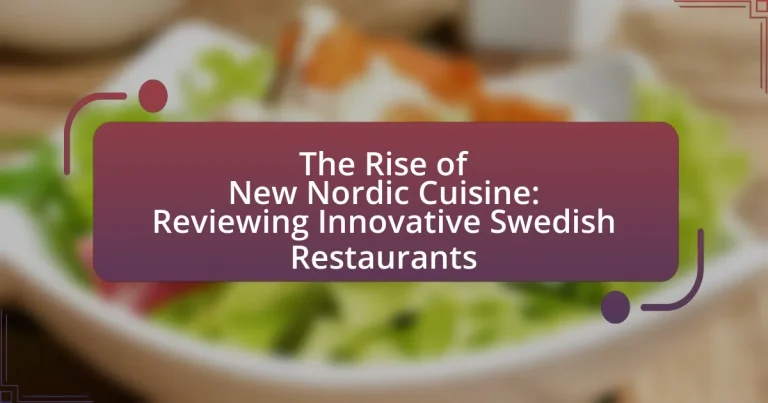New Nordic Cuisine is a culinary movement that emphasizes local, seasonal ingredients and traditional cooking methods, significantly impacting Swedish gastronomy since its emergence in the early 2000s. Spearheaded by influential chefs such as Magnus Nilsson and René Redzepi, this movement promotes sustainability, biodiversity, and a connection to Nordic cultural heritage. The article explores the historical and cultural factors that shaped New Nordic Cuisine, highlights key figures and innovative restaurants exemplifying this trend, and discusses the core principles that differentiate it from traditional Swedish cooking. Additionally, it provides insights into dining experiences, techniques for replicating this cuisine at home, and essential ingredients for aspiring cooks.

What is New Nordic Cuisine and its significance in Swedish gastronomy?
New Nordic Cuisine is a culinary movement that emphasizes local, seasonal ingredients and traditional cooking methods, significantly influencing Swedish gastronomy. This movement emerged in the early 2000s, spearheaded by chefs like Magnus Nilsson and René Redzepi, who advocated for a return to Nordic food traditions while incorporating modern techniques. The significance of New Nordic Cuisine in Sweden lies in its promotion of sustainability, biodiversity, and a strong connection to the region’s cultural heritage, which has led to a resurgence of interest in local produce and artisanal food practices. This approach has not only elevated Swedish cuisine on the global stage but also fostered a sense of identity and pride in local culinary practices.
How did New Nordic Cuisine emerge in Sweden?
New Nordic Cuisine emerged in Sweden as a movement focused on local, seasonal ingredients and traditional cooking methods, gaining prominence in the early 2000s. This culinary approach was formalized in 2004 when influential chefs, including Magnus Nilsson and Mathias Dahlgren, signed the New Nordic Cuisine Manifesto, which emphasized purity, freshness, and sustainability. The movement was further propelled by the establishment of restaurants like Noma in Denmark, which inspired Swedish chefs to innovate while honoring their culinary heritage. The emphasis on foraging and using native ingredients, such as cloudberries and wild herbs, became central to the cuisine, reflecting Sweden’s unique landscape and culture.
What historical and cultural factors influenced its development?
The development of New Nordic Cuisine was influenced by historical factors such as Sweden’s agricultural practices and cultural movements emphasizing local and seasonal ingredients. The shift towards sustainability and a return to traditional cooking methods, initiated in the late 20th century, played a crucial role. The establishment of the New Nordic Food Manifesto in 2004, signed by prominent chefs, further solidified this movement by promoting the use of Nordic ingredients and culinary heritage. This manifesto was a response to globalization and a desire to reconnect with local food sources, reflecting a cultural pride in Nordic identity and gastronomy.
Who are the key figures behind the New Nordic movement?
The key figures behind the New Nordic movement include chefs René Redzepi, Claus Meyer, and Magnus Nilsson. René Redzepi, co-founder of Noma in Copenhagen, is often regarded as the movement’s most influential figure, emphasizing local ingredients and foraging. Claus Meyer, also a co-founder of Noma, has played a significant role in promoting Nordic cuisine through various initiatives, including the establishment of the Nordic Food Lab. Magnus Nilsson, known for his work at Fäviken, has contributed to the movement by showcasing traditional Nordic cooking techniques and ingredients. These chefs have collectively shaped the New Nordic movement, which focuses on sustainability, seasonality, and a deep connection to the Nordic landscape.
What are the core principles of New Nordic Cuisine?
The core principles of New Nordic Cuisine emphasize the use of local, seasonal ingredients, simplicity in preparation, and a focus on traditional cooking methods. This culinary movement, which gained prominence in the early 2000s, advocates for sustainability and the promotion of Nordic food culture. It encourages chefs to explore the unique flavors of the Nordic region while respecting the environment and local ecosystems. The principles are rooted in the belief that food should be fresh, natural, and reflect the landscape of the region, thereby fostering a connection between the diner and the local environment.
How does seasonality play a role in ingredient selection?
Seasonality significantly influences ingredient selection by ensuring that chefs use fresh, locally sourced produce that is at its peak flavor and nutritional value. In the context of New Nordic Cuisine, which emphasizes sustainability and local ingredients, chefs prioritize seasonal items to create dishes that reflect the natural cycles of the environment. For example, root vegetables are typically harvested in the fall, while berries are abundant in the summer, allowing chefs to craft menus that change with the seasons, enhancing the dining experience and supporting local agriculture. This approach not only promotes biodiversity but also reduces the carbon footprint associated with transporting out-of-season ingredients.
What emphasis is placed on local and sustainable sourcing?
Local and sustainable sourcing is a fundamental principle in New Nordic Cuisine, emphasizing the use of ingredients that are locally produced and environmentally friendly. This approach not only supports local farmers and producers but also reduces the carbon footprint associated with transportation. For instance, many Swedish restaurants prioritize seasonal ingredients from nearby farms, ensuring freshness and quality while promoting biodiversity. Research indicates that restaurants focusing on local sourcing can enhance community ties and contribute to the local economy, as seen in the practices of acclaimed establishments like Noma and Fäviken, which have set benchmarks for sustainability in the culinary world.
Why is New Nordic Cuisine considered innovative?
New Nordic Cuisine is considered innovative because it emphasizes local, seasonal ingredients and traditional cooking methods while incorporating modern techniques. This culinary movement, which gained prominence in the early 2000s, seeks to redefine Nordic food culture by focusing on sustainability and foraging, as exemplified by restaurants like Noma in Copenhagen, which has received multiple accolades for its creative approach. The use of indigenous ingredients, such as sea buckthorn and wild herbs, showcases a commitment to regional biodiversity and culinary heritage, making it a distinct and forward-thinking gastronomic trend.
What techniques differentiate it from traditional Swedish cooking?
New Nordic Cuisine differentiates itself from traditional Swedish cooking primarily through its emphasis on local, seasonal ingredients and innovative cooking techniques. This modern approach often incorporates methods such as fermentation, pickling, and sous-vide, which enhance flavors and preserve the integrity of the ingredients. For instance, chefs in New Nordic restaurants frequently utilize foraged herbs and vegetables, showcasing a commitment to sustainability and regionality that contrasts with the more standardized recipes of traditional Swedish cuisine. The focus on presentation and artistic plating in New Nordic Cuisine also sets it apart, as seen in establishments like Noma, which has received multiple accolades for its avant-garde techniques and dedication to redefining Nordic food culture.
How does it incorporate modern culinary trends?
Innovative Swedish restaurants incorporate modern culinary trends by emphasizing local, seasonal ingredients and sustainable practices. This approach aligns with the global movement towards farm-to-table dining, where chefs prioritize fresh produce sourced from nearby farms. For instance, many restaurants in Sweden utilize foraged ingredients, reflecting a commitment to authenticity and environmental consciousness. Additionally, the use of fermentation and pickling techniques showcases a trend towards preserving flavors and enhancing nutritional value, which has gained popularity in contemporary gastronomy. These practices not only highlight the unique flavors of Nordic cuisine but also resonate with the increasing consumer demand for transparency and sustainability in food sourcing.

What are some innovative Swedish restaurants exemplifying New Nordic Cuisine?
Some innovative Swedish restaurants exemplifying New Nordic Cuisine include Noma, Oaxen Krog, and Frantzén. Noma, located in Copenhagen but often associated with Swedish culinary influences, has been pivotal in defining New Nordic Cuisine through its focus on local ingredients and innovative techniques. Oaxen Krog, situated on Djurgården Island in Stockholm, emphasizes sustainability and seasonal produce, showcasing traditional Swedish flavors with a modern twist. Frantzén, a Michelin-starred restaurant in Stockholm, combines Swedish culinary heritage with global influences, offering a unique tasting menu that highlights local ingredients. These restaurants collectively represent the principles of New Nordic Cuisine, which prioritizes freshness, locality, and innovation in food preparation.
Which restaurants are leading the New Nordic movement in Sweden?
The restaurants leading the New Nordic movement in Sweden include Noma, Oaxen Krog, and Frantzén. Noma, although based in Denmark, has significantly influenced Swedish cuisine and is often cited as a pioneer of the movement. Oaxen Krog, located on Djurgården Island in Stockholm, emphasizes sustainability and local ingredients, aligning with New Nordic principles. Frantzén, a Michelin-starred restaurant in Stockholm, combines innovative techniques with traditional Swedish flavors, showcasing the essence of New Nordic cuisine. These establishments exemplify the movement’s focus on seasonal, local, and foraged ingredients, contributing to its growth and recognition in Sweden.
What unique dishes do these restaurants offer?
Innovative Swedish restaurants offer unique dishes such as fermented herring, reindeer tartare, and cloudberry desserts. Fermented herring, known as surströmming, is a traditional dish that showcases the preservation techniques of Nordic cuisine. Reindeer tartare highlights the use of local game meats, emphasizing sustainability and regional sourcing. Cloudberry desserts, often served as jams or in pastries, reflect the use of native berries that are integral to Swedish culinary heritage. These dishes exemplify the principles of New Nordic Cuisine, which focuses on local ingredients, seasonal produce, and traditional cooking methods.
How do these restaurants reflect the principles of New Nordic Cuisine?
These restaurants reflect the principles of New Nordic Cuisine by emphasizing local, seasonal ingredients and traditional cooking methods. They prioritize the use of native produce, such as foraged herbs and wild game, which aligns with the movement’s focus on sustainability and regional identity. For instance, many of these establishments source their ingredients from nearby farms and fisheries, showcasing the freshness and quality of local products. Additionally, they often incorporate innovative techniques that enhance the natural flavors of these ingredients, demonstrating a commitment to culinary creativity while respecting the environment. This approach not only supports local economies but also fosters a deeper connection between the diners and the Nordic landscape.
What dining experiences do these innovative restaurants provide?
Innovative Swedish restaurants provide unique dining experiences that emphasize local ingredients, sustainability, and creativity in presentation. These establishments often feature tasting menus that showcase seasonal produce and traditional Nordic flavors, allowing diners to explore a range of dishes in a single meal. For example, many restaurants incorporate foraged ingredients, reflecting the region’s natural bounty, and utilize modern cooking techniques to enhance flavors and textures. This approach not only highlights the culinary heritage of Sweden but also aligns with the global trend towards sustainable dining practices, as evidenced by the increasing number of restaurants receiving accolades for their commitment to environmental responsibility.
How do ambiance and service enhance the culinary experience?
Ambiance and service significantly enhance the culinary experience by creating an environment that complements the food and fosters customer satisfaction. A well-designed ambiance, characterized by elements such as lighting, decor, and music, can evoke emotions and set the mood, making the dining experience more enjoyable. For instance, research indicates that atmospheric factors can influence taste perception, with studies showing that diners rate food more favorably in aesthetically pleasing settings.
Service quality further elevates the culinary experience by ensuring that guests feel valued and attended to. Efficient and attentive service can enhance the enjoyment of a meal, as it allows diners to focus on the food without distractions. According to a study published in the Journal of Hospitality & Tourism Research, high service quality correlates with increased customer satisfaction and loyalty, demonstrating that attentive service can significantly impact the overall dining experience.
Together, ambiance and service create a holistic dining environment that not only enhances the enjoyment of the food but also encourages repeat visits and positive word-of-mouth.
What role does presentation play in these restaurants’ offerings?
Presentation plays a crucial role in the offerings of innovative Swedish restaurants by enhancing the dining experience and reflecting the ethos of New Nordic cuisine. The visual appeal of dishes not only attracts customers but also communicates the restaurant’s commitment to quality and creativity. For instance, meticulously arranged plates can highlight the freshness of local ingredients, which is a fundamental principle of New Nordic cuisine. Research indicates that diners often associate well-presented food with superior taste and quality, reinforcing the importance of aesthetics in culinary offerings.

How can one explore and appreciate New Nordic Cuisine in Sweden?
To explore and appreciate New Nordic Cuisine in Sweden, one should visit renowned restaurants that exemplify this culinary movement, such as Noma in Copenhagen, which has influenced Swedish chefs, and Oaxen Slip in Stockholm, known for its focus on local ingredients. Engaging in food tours that highlight seasonal and foraged ingredients can deepen understanding, as many dishes emphasize sustainability and regional flavors. Additionally, participating in cooking classes led by local chefs can provide hands-on experience with traditional techniques and ingredients unique to the Nordic region. The New Nordic Cuisine movement, officially defined in 2004 by the Copenhagen-based chefs, emphasizes purity, freshness, and ethical sourcing, making these experiences not only enjoyable but also educational.
What are the best practices for dining at innovative Swedish restaurants?
To dine effectively at innovative Swedish restaurants, guests should embrace the New Nordic Cuisine philosophy, which emphasizes local, seasonal ingredients and sustainability. Understanding the menu is crucial; diners should inquire about the sourcing of ingredients and the preparation methods, as many dishes reflect traditional techniques with modern twists. Engaging with the staff enhances the experience, as they can provide insights into the culinary concepts and recommend pairings, particularly with local beverages. Additionally, being open to tasting menus allows diners to experience a broader range of flavors and creativity that these restaurants offer. This approach aligns with the trend of experiential dining, where the journey of the meal is as important as the food itself.
How should one approach the menu to fully experience New Nordic Cuisine?
To fully experience New Nordic Cuisine, one should approach the menu by selecting a variety of dishes that highlight local ingredients, seasonal produce, and traditional cooking techniques. This cuisine emphasizes the use of fresh, foraged, and sustainable ingredients sourced from the Nordic region, which enhances the flavors and authenticity of the dining experience. By ordering a tasting menu or a selection of small plates, diners can appreciate the creativity and innovation that characterize New Nordic Cuisine, as well as the cultural significance behind each dish. This approach allows for a comprehensive exploration of the culinary philosophy that prioritizes simplicity, purity, and respect for nature, which are foundational elements of New Nordic Cuisine.
What tips can enhance the overall dining experience?
To enhance the overall dining experience, focus on the quality of ingredients, ambiance, and service. High-quality, locally sourced ingredients are essential in New Nordic cuisine, as they contribute to the freshness and flavor of the dishes. A well-designed ambiance, including lighting and decor, can significantly affect diners’ mood and enjoyment, creating a memorable atmosphere. Additionally, attentive and knowledgeable service enhances the experience by providing insights into the menu and ensuring that guests feel valued. Research indicates that a positive dining atmosphere can increase customer satisfaction by up to 30%, highlighting the importance of these elements in creating an exceptional dining experience.
How can one replicate New Nordic Cuisine at home?
To replicate New Nordic Cuisine at home, one should focus on using local, seasonal ingredients and traditional cooking techniques. This culinary movement emphasizes freshness and sustainability, often incorporating foraged items and minimal processing. For example, utilizing ingredients like root vegetables, fish, and herbs native to the Nordic region can create authentic dishes. Additionally, techniques such as pickling, fermenting, and smoking are commonly employed in New Nordic recipes, enhancing flavors while preserving the integrity of the ingredients. This approach aligns with the principles established by influential chefs like René Redzepi of Noma, who advocates for a deep connection to the local environment and culinary heritage.
What essential ingredients should be stocked for New Nordic cooking?
Essential ingredients for New Nordic cooking include fresh, seasonal vegetables, whole grains, fish, game meats, and foraged herbs. These ingredients reflect the philosophy of using local and sustainable produce, which is central to New Nordic cuisine. For example, root vegetables like carrots and potatoes are staples, while fish such as herring and salmon are commonly used due to their availability in Nordic waters. Game meats like reindeer and venison are also significant, as they are traditional sources of protein in the region. Additionally, foraged herbs like wild garlic and mushrooms enhance the flavors and authenticity of dishes, aligning with the movement’s emphasis on natural and local ingredients.
What techniques can home cooks learn from New Nordic chefs?
Home cooks can learn techniques such as foraging, fermentation, and the use of seasonal, local ingredients from New Nordic chefs. Foraging encourages cooks to explore their environment for edible plants, enhancing flavor and sustainability. Fermentation techniques, which are integral to New Nordic cuisine, help preserve ingredients and develop complex flavors, as seen in dishes that utilize fermented vegetables or grains. Additionally, the emphasis on seasonal and local ingredients promotes freshness and supports local agriculture, aligning with the principles of New Nordic cuisine that prioritize quality and sustainability. These techniques not only elevate home cooking but also foster a deeper connection to food sources.




